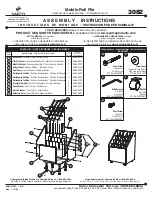
Chapter 8
Sample preparation
Page 8-8
MAN 0384
Sodium Oxalate
Calcium Chloride
As many of these are solid materials that are dissolved into the dispersant, the solu-
tion should be filtered after preparation to remove impurities.
Slurries
The act of mixing up a small quantity of concentrated sample, dispersant and addi-
tives before it is added to the dispersion unit tank is known as preparing a slurry.
Once the particles have been successfully dispersed into a slurry, the sample may be
added to the dispersion unit without any further additions of surfactants etc. The
problem of the sample settling out within the beaker can be solved by using a
pipette to continually stir the sample. While stirring, continually fill and empty the
pipette. Use the pipette to add the sample to the dispersion unit tank.
Use of ultrasonics
In addition to the processes described above, ultrasonics can be applied to help the
dispersion, whether or not it contains a surfactant.
When mixing the sample in the suspension medium, a visual inspection often
shows whether ultrasonics are necessary. If large agglomerates of particles sink to
the bottom of the beaker, try applying two minutes of ultrasonics by placing the
slurry and its beaker in an ultrasonic bath. It will be immediately apparent if this has
been effective. Further ultrasonics can be applied when the sample is added to the
tank, if necessary. This often prevents re-agglomeration, but is not always needed.
Note
Be wary of using ultrasonics with fragile particles; the ultrasonic action
may break up the particles themselves. If in any doubt, microscopic obser-
vation before and after the ultrasonics can establish whether it has helped.
Samples with unstable concentrations
When adding the sample to the dispersion unit tank using the software’s
Add sam-
ple
facility, users may experience obscurations that change during the dispersion
period. Most samples disperse very quickly so users will not notice the obscuration
value rising. With some samples the slow dispersion of the sample can be clearly
seen. Do not make a measurement until the obscuration has stabilised, indicating
that the sample has properly dispersed. When adding very fine material and relying
on the action of the ultrasonics to achieve a good dispersion, add less sample than
you would expect. The action of the ultrasonics will cause the obscuration to rise.
i
MAN0384-1.0 Mastersizer 2000.book Page 8 Tuesday, March 20, 2007 8:56 AM
Summary of Contents for Mastersizer 2000
Page 2: ......
Page 6: ...Page 2 Addendum 0070 2 0 Addendum 0070 2 0 fm Page 2 Wednesday March 10 2010 11 58 AM ...
Page 14: ...MAN0384 1 0 Mastersizer 2000 book Page 2 Tuesday March 20 2007 8 56 AM ...
Page 124: ...MAN0384 1 0 Mastersizer 2000 book Page 2 Tuesday March 20 2007 8 56 AM ...
Page 133: ...Part 3 Appendices MAN0384 1 0 Mastersizer 2000 book Page 1 Tuesday March 20 2007 8 56 AM ...
Page 134: ...MAN0384 1 0 Mastersizer 2000 book Page 2 Tuesday March 20 2007 8 56 AM ...
Page 153: ......
Page 154: ......
















































